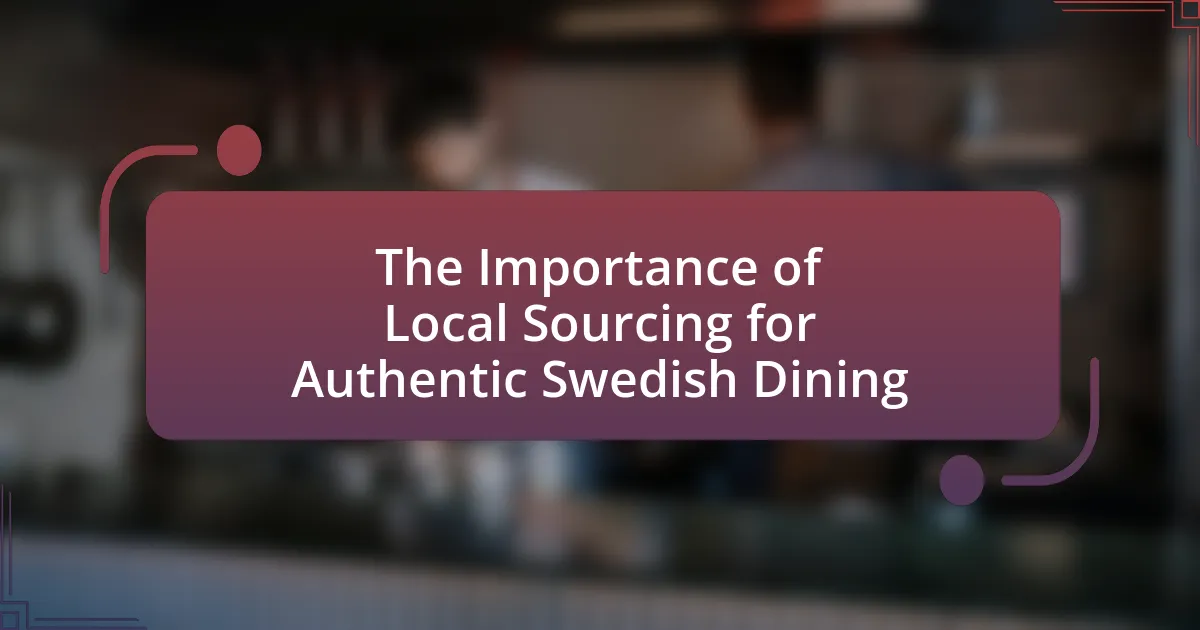The article examines the evolution of Swedish restaurant menus over the decades, highlighting key historical influences such as agricultural practices, cultural exchanges, and economic changes. It details how traditional Swedish cuisine shaped early menus, the impact of globalization and immigration on menu diversity, and the significant shifts in dining trends from the 1950s to the present. The discussion includes the rise of health-conscious and sustainable dining options, the incorporation of international cuisines, and the role of technology in modern menu design. Additionally, it addresses current trends in dietary preferences and innovative practices that enhance customer engagement and satisfaction in Swedish restaurants.

What are the key historical influences on Swedish restaurant menus?
Key historical influences on Swedish restaurant menus include agricultural practices, cultural exchanges, and economic changes. The agrarian society of Sweden historically shaped menus by emphasizing locally sourced ingredients such as fish, game, and root vegetables. The introduction of new ingredients during the 17th century, particularly from trade with other countries, diversified Swedish cuisine. Additionally, the industrial revolution in the 19th century led to urbanization, which influenced dining habits and the emergence of restaurants that catered to a growing working class. These factors collectively contributed to the evolution of Swedish restaurant menus, reflecting both traditional and modern culinary practices.
How did traditional Swedish cuisine shape early restaurant menus?
Traditional Swedish cuisine significantly influenced early restaurant menus by emphasizing local ingredients and traditional cooking methods. Early menus featured staple dishes such as herring, meatballs, and gravlax, reflecting the agricultural and fishing practices of Sweden. The use of seasonal produce and preservation techniques, like pickling and smoking, became foundational elements in these menus, showcasing the country’s culinary heritage. This focus on regional flavors and traditional recipes helped establish a distinct identity for Swedish restaurants, promoting a sense of cultural pride and continuity in dining experiences.
What ingredients were commonly used in early Swedish dishes?
Early Swedish dishes commonly featured ingredients such as barley, rye, fish, and root vegetables. Barley and rye were staple grains used for bread and porridge, while fish, particularly herring and salmon, were abundant due to Sweden’s extensive coastline. Root vegetables like potatoes, carrots, and turnips were essential for sustenance, especially during the long winters. Historical records indicate that these ingredients formed the basis of traditional Swedish cuisine, reflecting the agricultural practices and available resources of the region.
How did regional variations impact menu offerings?
Regional variations significantly influenced menu offerings by introducing diverse local ingredients and culinary traditions into Swedish cuisine. For instance, coastal regions emphasized seafood dishes, while inland areas focused on game and root vegetables, reflecting the availability of resources. This resulted in a rich tapestry of flavors and preparations, such as the prevalence of herring in the west and reindeer in the north. Historical records indicate that these regional specialties became staples in local restaurants, showcasing the unique identity of each area and catering to the preferences of local patrons.
What role did globalization play in the evolution of Swedish menus?
Globalization significantly influenced the evolution of Swedish menus by introducing diverse culinary traditions and ingredients from around the world. As Sweden became more interconnected with global markets, restaurants began incorporating international flavors, such as Asian spices, Mediterranean dishes, and American fast food, reflecting a broader trend towards fusion cuisine. This shift is evidenced by the rise of sushi bars in the 1990s and the popularity of tacos and burgers in contemporary Swedish dining, showcasing how global culinary trends have reshaped local eating habits and preferences.
How did international culinary trends influence Swedish dining?
International culinary trends significantly influenced Swedish dining by introducing diverse flavors, techniques, and ingredients, leading to a more globalized food culture. For instance, the rise of Mediterranean and Asian cuisines in the late 20th century prompted Swedish chefs to incorporate spices, herbs, and cooking methods from these regions into traditional Swedish dishes. This fusion is evident in the popularity of sushi and tapas in Sweden, which have become staples in many restaurants. Additionally, the emphasis on sustainability and local sourcing, inspired by international movements, has reshaped Swedish dining, encouraging the use of seasonal ingredients and organic produce. This evolution reflects a broader trend where Swedish menus increasingly feature a blend of local and global influences, enhancing the culinary landscape.
What were the effects of immigration on menu diversity?
Immigration significantly enhanced menu diversity in Sweden by introducing a variety of international cuisines. As immigrants settled in Sweden, they brought their culinary traditions, ingredients, and cooking techniques, which led to the incorporation of dishes from regions such as the Middle East, Asia, and Africa into Swedish restaurants. For instance, the rise of kebab shops and sushi bars in urban areas reflects this diversification, with statistics showing that ethnic restaurants have increased by over 50% in the last two decades. This influx of diverse food options has not only broadened consumer choices but also enriched the cultural tapestry of Swedish dining experiences.

How have Swedish restaurant menus changed from the 1950s to the present?
Swedish restaurant menus have evolved significantly from the 1950s to the present, transitioning from traditional, meat-centric dishes to a diverse array of international cuisines and plant-based options. In the 1950s, menus primarily featured classic Swedish fare such as meatballs, herring, and potatoes, reflecting local ingredients and culinary traditions. Over the decades, globalization and changing consumer preferences have led to the incorporation of Mediterranean, Asian, and Middle Eastern influences, as well as a growing emphasis on sustainability and health. For instance, the rise of vegetarianism and veganism has prompted many restaurants to offer innovative plant-based dishes, aligning with contemporary dietary trends. This shift is supported by data indicating that the number of vegetarian and vegan restaurants in Sweden has increased significantly, reflecting a broader societal change towards more varied and health-conscious dining options.
What were the defining characteristics of menus in the 1950s and 1960s?
Menus in the 1950s and 1960s were characterized by a focus on convenience, simplicity, and a reflection of post-war consumer culture. During this period, many restaurants adopted a streamlined approach, featuring a limited selection of dishes that emphasized quick preparation and service, catering to the growing demand for fast dining options.
Additionally, menus often showcased classic American dishes, such as hamburgers, meatloaf, and casseroles, which became staples in Swedish restaurants influenced by American dining trends. The use of vibrant graphics and colorful designs on menus also became popular, appealing to a more visually oriented consumer base.
Furthermore, the introduction of frozen and pre-packaged foods during this era allowed restaurants to offer a wider variety of dishes with less labor, further shaping the menu landscape. This shift was indicative of broader societal changes, including increased urbanization and the rise of the middle class, which influenced dining habits and preferences.
Which dishes were staples during this period?
During this period, staples included meatballs, herring, and gravlax. Meatballs, often served with lingonberry sauce and potatoes, became a quintessential dish in Swedish cuisine, reflecting the country’s agricultural practices. Herring, pickled or cured, was a common fish dish due to Sweden’s extensive coastline and fishing traditions. Gravlax, a cured salmon dish, showcased the preservation methods used historically in Swedish households. These dishes not only represent the culinary preferences of the time but also highlight the influence of local ingredients and traditional cooking techniques in Swedish gastronomy.
How did societal changes influence menu selections?
Societal changes significantly influenced menu selections by shifting consumer preferences towards healthier, sustainable, and diverse food options. For instance, the rise of health consciousness in the late 20th century led restaurants to incorporate more organic and plant-based dishes, reflecting a growing awareness of nutrition and wellness. Additionally, globalization introduced a variety of international cuisines to Swedish menus, catering to an increasingly multicultural population. This trend is evidenced by the increase in ethnic restaurants and fusion cuisine offerings, which have become staples in urban areas. Furthermore, the environmental movement has prompted many establishments to prioritize locally sourced ingredients, aligning with societal values around sustainability and ethical consumption.
What significant shifts occurred in the 1970s and 1980s?
Significant shifts in Swedish restaurant menus during the 1970s and 1980s included a move towards international cuisine and an emphasis on health-conscious options. This period saw the introduction of Mediterranean and Asian dishes, reflecting a growing interest in global flavors. Additionally, the rise of dietary awareness led to increased availability of vegetarian and low-fat meals, aligning with broader societal trends towards healthier eating. The 1970s also marked the beginning of a shift from traditional Swedish fare to more diverse offerings, influenced by immigration and changing consumer preferences.
How did health trends affect menu offerings?
Health trends significantly influenced menu offerings by prompting restaurants to incorporate healthier ingredients and options. As consumer awareness of nutrition increased, many Swedish restaurants began to offer more plant-based dishes, whole grains, and organic ingredients. For instance, the rise of vegetarianism and veganism led to a notable increase in meat-free options on menus, reflecting a shift towards sustainable eating practices. Additionally, the demand for transparency in food sourcing resulted in restaurants highlighting locally sourced and seasonal ingredients, aligning with health-conscious consumer preferences. This evolution in menu offerings is supported by data from the Swedish Food Agency, which reported a 30% increase in plant-based food consumption among Swedes from 2015 to 2020, illustrating the direct impact of health trends on dining choices.
What new cuisines emerged in Swedish restaurants during this time?
During this time, new cuisines such as Asian fusion, Middle Eastern, and modern Nordic emerged in Swedish restaurants. Asian fusion introduced elements from Chinese, Thai, and Japanese cuisines, often blending traditional Swedish ingredients with Asian flavors. Middle Eastern cuisine gained popularity, featuring dishes like falafel and shawarma, reflecting a growing interest in diverse flavors. Modern Nordic cuisine, characterized by a focus on local and seasonal ingredients, also became prominent, emphasizing sustainability and innovative cooking techniques. These trends indicate a significant shift in the culinary landscape of Sweden, showcasing a blend of global influences and local traditions.
What trends have shaped menus in the 1990s to the present?
Menus from the 1990s to the present have been shaped by trends such as globalization, health consciousness, and sustainability. Globalization has introduced diverse cuisines and fusion dishes, reflecting a broader range of cultural influences in Swedish restaurants. Health consciousness has led to an increased demand for organic, vegetarian, and gluten-free options, as consumers prioritize nutrition and dietary restrictions. Sustainability has become a significant focus, with many establishments sourcing local ingredients and emphasizing eco-friendly practices, aligning with the growing awareness of environmental issues. These trends have collectively transformed the dining experience, making menus more varied and aligned with contemporary values.
How has the farm-to-table movement influenced menu design?
The farm-to-table movement has significantly influenced menu design by prioritizing local, seasonal ingredients and emphasizing transparency in sourcing. This shift has led restaurants to create menus that highlight the origin of their ingredients, often listing local farms and producers, which enhances the dining experience by connecting consumers with their food sources. Research indicates that menus now frequently feature dishes that change with the seasons, reflecting the availability of fresh produce, thereby promoting sustainability and reducing carbon footprints associated with food transportation. This trend not only caters to consumer demand for healthier, fresher options but also aligns with a growing awareness of environmental impacts, making farm-to-table principles a central theme in contemporary menu design.
What role does sustainability play in modern Swedish menus?
Sustainability is a central theme in modern Swedish menus, reflecting a commitment to environmentally friendly practices and local sourcing. Swedish restaurants prioritize seasonal ingredients, often sourced from local farms, to minimize carbon footprints and support regional economies. For instance, the Swedish government has promoted initiatives like the “Swedish Food Revolution,” which encourages restaurants to adopt sustainable practices, leading to a significant increase in the use of organic and locally produced foods. This shift not only enhances the quality of dishes but also aligns with consumer demand for transparency and ethical sourcing in food production.

What are the current trends in Swedish restaurant menus?
Current trends in Swedish restaurant menus include a strong emphasis on sustainability, local sourcing, and plant-based options. Many restaurants are increasingly prioritizing organic and seasonal ingredients, reflecting a growing consumer demand for environmentally friendly practices. For instance, the Swedish government has reported a significant rise in the number of restaurants offering vegetarian and vegan dishes, with a 30% increase in plant-based menu items over the past few years. Additionally, traditional Swedish cuisine is being reinterpreted with modern techniques and global influences, showcasing a blend of heritage and innovation.
How are dietary preferences reflected in contemporary menus?
Contemporary menus reflect dietary preferences through the inclusion of diverse options catering to various dietary needs, such as vegetarian, vegan, gluten-free, and allergen-free dishes. This trend is driven by increasing consumer awareness and demand for healthier, sustainable, and ethically sourced food. For instance, a report by the National Restaurant Association in 2022 indicated that 60% of consumers are more likely to choose a restaurant that offers plant-based options, highlighting the shift towards accommodating dietary preferences in menu design.
What options are available for vegetarian and vegan diners?
Vegetarian and vegan diners have a variety of options available, including plant-based dishes, salads, vegetable-based soups, and meat alternatives made from soy, legumes, or grains. In Sweden, the evolution of restaurant menus has increasingly incorporated these options, reflecting a growing demand for sustainable and ethical dining choices. According to a 2021 report by the Swedish Food Agency, approximately 10% of the Swedish population identifies as vegetarian or vegan, prompting restaurants to adapt their menus to include diverse and flavorful plant-based offerings.
How are gluten-free and allergen-friendly dishes incorporated?
Gluten-free and allergen-friendly dishes are incorporated into Swedish restaurant menus by adapting traditional recipes and utilizing alternative ingredients. Restaurants often replace wheat flour with gluten-free options like almond flour or rice flour, ensuring that dishes remain flavorful while catering to dietary restrictions. Additionally, many establishments now label their menus clearly, indicating which items are gluten-free or free from common allergens, thus enhancing transparency and customer choice. This shift reflects a broader trend in the food industry towards inclusivity, driven by increasing awareness of food allergies and gluten sensitivities among consumers.
What innovative practices are being adopted in menu creation?
Innovative practices in menu creation include the integration of digital technology, seasonal sourcing, and personalized dining experiences. Restaurants are increasingly utilizing digital menus and apps to enhance customer engagement and streamline ordering processes. Seasonal sourcing emphasizes the use of local and fresh ingredients, which not only supports local farmers but also aligns with sustainability trends. Personalized dining experiences, such as customizable dishes and dietary accommodations, cater to individual preferences and dietary restrictions, reflecting a growing consumer demand for tailored options. These practices are supported by industry trends indicating a shift towards sustainability and technology in the culinary landscape.
How are chefs using local ingredients to enhance menu appeal?
Chefs are using local ingredients to enhance menu appeal by incorporating seasonal produce and regional specialties, which not only supports local agriculture but also creates unique and fresh dining experiences. For instance, Swedish chefs often feature locally sourced fish, such as herring and salmon, alongside vegetables like root crops and berries that are abundant in the region. This practice not only emphasizes the freshness and quality of the dishes but also connects diners to the local culture and environment, making the menu more appealing. Studies show that menus highlighting local ingredients can increase customer satisfaction and loyalty, as diners appreciate the authenticity and sustainability of their meals.
What technology is influencing menu design and customer interaction?
Digital technology, particularly mobile applications and interactive kiosks, is significantly influencing menu design and customer interaction. These technologies enable restaurants to offer dynamic menus that can be easily updated in real-time, allowing for seasonal changes and special promotions. For instance, mobile apps facilitate personalized customer experiences by suggesting dishes based on previous orders or dietary preferences. Additionally, interactive kiosks enhance customer engagement by allowing patrons to customize their orders and view detailed nutritional information, which aligns with the growing demand for transparency in food choices. This shift towards technology-driven solutions is supported by research indicating that 70% of consumers prefer using digital menus for their convenience and interactivity.
What practical tips can restaurants implement for menu success?
Restaurants can achieve menu success by focusing on seasonal ingredients, which enhances freshness and flavor while appealing to customer preferences for local and sustainable options. Utilizing seasonal ingredients can lead to a 20% increase in customer satisfaction, as studies show diners prefer dishes that reflect the current season. Additionally, implementing clear and concise menu descriptions can improve customer decision-making, with research indicating that well-written descriptions can boost sales by up to 27%. Lastly, regularly updating the menu based on customer feedback and sales data ensures that offerings remain relevant and appealing, contributing to sustained interest and repeat business.
How can restaurants effectively balance tradition and innovation in their menus?
Restaurants can effectively balance tradition and innovation in their menus by incorporating classic recipes with modern techniques and ingredients. This approach allows establishments to honor cultural heritage while appealing to contemporary tastes. For instance, Swedish restaurants can take traditional dishes like meatballs and enhance them with locally sourced, seasonal ingredients or innovative cooking methods such as sous-vide. This method not only preserves the essence of the original dish but also introduces new flavors and textures, making it relevant to today’s diners. Additionally, research shows that 70% of consumers appreciate restaurants that offer a blend of traditional and innovative options, indicating a strong market demand for this balance.
What strategies can be used to engage customers through menu design?
Engaging customers through menu design can be achieved by utilizing strategies such as visual hierarchy, descriptive language, and thematic consistency. Visual hierarchy involves organizing menu items in a way that draws attention to high-margin or signature dishes, often through the use of bold fonts or strategic placement. Descriptive language enhances the appeal of dishes by evoking sensory experiences, which can increase customer interest and perceived value. Thematic consistency ensures that the menu aligns with the restaurant’s overall concept, creating a cohesive experience that resonates with customers. Research indicates that well-designed menus can increase sales by up to 30%, demonstrating the effectiveness of these strategies in engaging customers.





